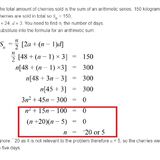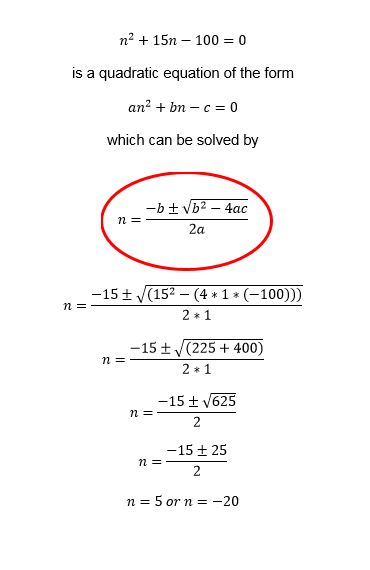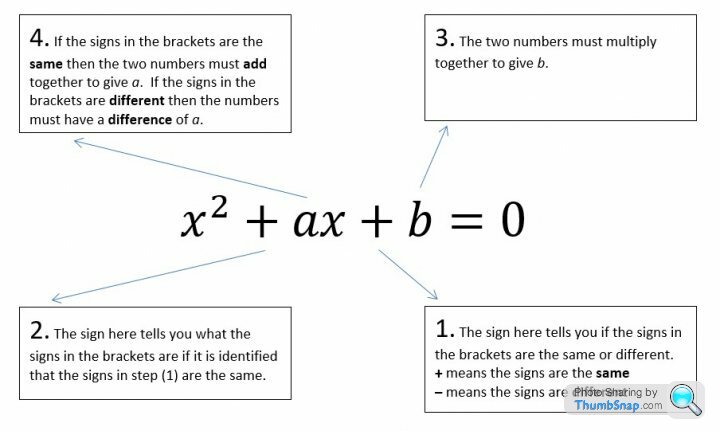Discussion
I don't know how advanced your course gets, but either way, get yourself a copy of this:
https://www.amazon.co.uk/Engineering-Mathematics-K...
https://www.amazon.co.uk/Engineering-Mathematics-K...
Tony Starks said:
I'm so glad I dont need to program the machines I use 
Right, this has me stumped. I cant seem to get the the answer to work out correctly.
Josh has started jogging to keep fit. On the first day he jogs 3 kilometres. Each day he adds 0.5 kilometres to the length of his jog. Josh plans to keep increasing the distance he jogs until he gets to jog 8 kilometres.
How many days will it take for Josh to complete one jog of 8 kilometres?
So I've been using the formula for an Arithmetic Series :
Sn = n/2 [2a + (n-1)d]
As well as the tn = a+(n-1)d formula.
If I write it down, the bow legged muppet will take 11 days to reach 8km.
If I use the tn formula it comes out as 6.5 days to reach 8km.
Rather than focus on forcing a question into an arithmetic series, i would start by writing the question out in a slightly more arithmetic form, and work out the equation over a couple of lines from first principles. So;
Right, this has me stumped. I cant seem to get the the answer to work out correctly.
Josh has started jogging to keep fit. On the first day he jogs 3 kilometres. Each day he adds 0.5 kilometres to the length of his jog. Josh plans to keep increasing the distance he jogs until he gets to jog 8 kilometres.
How many days will it take for Josh to complete one jog of 8 kilometres?
So I've been using the formula for an Arithmetic Series :
Sn = n/2 [2a + (n-1)d]
As well as the tn = a+(n-1)d formula.
If I write it down, the bow legged muppet will take 11 days to reach 8km.
If I use the tn formula it comes out as 6.5 days to reach 8km.
Edited by Tony Starks on Sunday 7th February 04:11
Edited by Tony Starks on Sunday 7th February 20:47
Distance travelled equals 3km + half km per extra day
Dist = 3 + 0.5 (day - 1)
8 = 3 + 0.5 (day - 1)
5 = 0.5 (day - 1)
10 = day - 1
11 = day
Hope that makes sense!
From an understanding point of view it might be first reviewing how it works the other way
So
(N+20)(N-5) = 0
Multiply out the brackets by
N times N = N²
N times -5 = -5N
N times + 20 = 20N
20 times - 5 = - 100
Put them together N² + 20N - 5N - 100 = 0 and a bit of simplification of 20N - 5N = 15N to get N² + 15N - 100 = 0
So
(N+20)(N-5) = 0
Multiply out the brackets by
N times N = N²
N times -5 = -5N
N times + 20 = 20N
20 times - 5 = - 100
Put them together N² + 20N - 5N - 100 = 0 and a bit of simplification of 20N - 5N = 15N to get N² + 15N - 100 = 0
Tony Starks said:
Thanks for the help so far 
all that seems so easy now lol.
my biggest problem now is factorising Quadratics. I've highlighted the bit I'm stuck on:
How does 'n squared + 15n - 100 =0' turn into '(n+20)(n-5) = 0' ?

Solving quadratics:
all that seems so easy now lol.
my biggest problem now is factorising Quadratics. I've highlighted the bit I'm stuck on:
How does 'n squared + 15n - 100 =0' turn into '(n+20)(n-5) = 0' ?


The bit in red is the quadratic formula - it's really useful.
Halmyre said:
Even when you get sqrt.(-1)! But that's for the next lesson I think 
As may be the equation itself.
Tony may "have" to use the factorising method as an aid to understanding the nuts & bolts of how quadratics work before being allowed the formula method.
jet_noise said:
Halmyre said:
Even when you get sqrt.(-1)! But that's for the next lesson I think 
As may be the equation itself.
Tony may "have" to use the factorising method as an aid to understanding the nuts & bolts of how quadratics work before being allowed the formula method.
Halmyre said:
jet_noise said:
Halmyre said:
Even when you get sqrt.(-1)! But that's for the next lesson I think 
As may be the equation itself.
Tony may "have" to use the factorising method as an aid to understanding the nuts & bolts of how quadratics work before being allowed the formula method.
Just to confuse you even more, this I think is the NZ version of GCSE or A level , this is all NCEA level 2 and rather than obtaining an A, B or C etc. It's done on credits. I think for this it's worth 4 credits and to get an A+ I need 80 credits.
Working out how they do things over here is worse than quadratic equations
Tony Starks said:
Thanks for the help so far 
all that seems so easy now lol.
my biggest problem now is factorising Quadratics. I've highlighted the bit I'm stuck on:
How does 'n squared + 15n - 100 =0' turn into '(n+20)(n-5) = 0' ?

Here's a little step-by-step guide on how to factorise a quadratic where the coefficient of x^2 is 1.
all that seems so easy now lol.
my biggest problem now is factorising Quadratics. I've highlighted the bit I'm stuck on:
How does 'n squared + 15n - 100 =0' turn into '(n+20)(n-5) = 0' ?


Always start with what you know.
write your sets of empty brackets: ( )( )
We have an x^2 term so put in the x's: (x )(x )
Right, now start at step 1. Look at the signs in your quadratic, one is + and the other is -, therefore the signs are different so the signs in the brackets are different. It doesn't matter which way round they go, but I like to put + in the first one, but that's just my preference: (x + )(x - ).
Step 2 doesn't apply because your signs are different, so onto step 3. We need two numbers that multiply together to give 100. Let's think of the factors of 100:
1 & 100
2 & 50
4 & 25
5 & 20
10 & 10
The two numbers will be one of those pairs.
Step 4. Because the signs in the brackets are different, it means the two numbers must have a difference of 15. Therefore our number pair is 5 & 20.
Now, as the signs in the brackets are different we need to check which way round to put the numbers in to end up with "-15".
( +20)( - 5) is going to give +15
( +5)( - 20) is going to give -15, the right answer.
Our final brackets are, therefore, (x + 5)(x - 20)=0
Gassing Station | Science! | Top of Page | What's New | My Stuff



